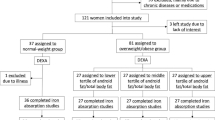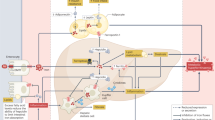Abstract
Context:
Obesity is associated with hypoferremia, but it is unclear if this condition is caused by insufficient iron stores or diminished iron availability related to inflammation-induced iron sequestration.
Objective:
To examine the relationships between obesity, serum iron, measures of iron intake, iron stores and inflammation. We hypothesized that both inflammation-induced sequestration of iron and true iron deficiency were involved in the hypoferremia of obesity.
Design:
Cross-sectional analysis of factors anticipated to affect serum iron.
Setting:
Outpatient clinic visits.
Patients:
Convenience sample of 234 obese and 172 non-obese adults.
Main outcome measures:
Relationships between serum iron, adiposity, and serum transferrin receptor, C-reactive protein, ferritin, and iron intake analyzed by analysis of covariance and multiple linear regression.
Results:
Serum iron was lower (75.8±35.2 vs 86.5±34.2 g/dl, P=0.002), whereas transferrin receptor (22.6±7.1 vs 21.0±7.2 nmol/l, P=0.026), C-reactive protein (0.75±0.67 vs 0.34±0.67 mg/dl, P<0.0001) and ferritin (81.1±88.8 vs 57.6±88.7 μg/l, P=0.009) were higher in obese than non-obese subjects. Obese subjects had a higher prevalence of iron deficiency defined by serum iron (24.3%, confidence intervals (CI) 19.3–30.2 vs 15.7%, CI 11.0–21.9%, P=0.03) and transferrin receptor (26.9%, CI 21.6–33.0 vs 15.7%, CI 11.0–21.9%, P=0.0078) but not by ferritin (9.8%, CI 6.6–14.4 vs 9.3%, CI 5.7–14.7%, P=0.99). Transferrin receptor, ferritin and C-reactive protein contributed independently as predictors of serum iron.
Conclusions:
The hypoferremia of obesity appears to be explained both by true iron deficiency and by inflammatory-mediated functional iron deficiency.
This is a preview of subscription content, access via your institution
Access options
Subscribe to this journal
Receive 12 print issues and online access
$259.00 per year
only $21.58 per issue
Buy this article
- Purchase on Springer Link
- Instant access to full article PDF
Prices may be subject to local taxes which are calculated during checkout


Similar content being viewed by others
References
Wenzel BJ, Stults HB, Mayer J . Hypoferraemia in obese adolescents. Lancet 1962; 2: 327–328.
Seltzer CC, Mayer J . Serum iron and iron-binding capacity in adolescents. Ii. Comparison of obese and nonobese subjects. Am J Clin Nutr 1963; 13: 354–361.
Pinhas-Hamiel O, Newfield RS, Koren I, Agmon A, Lilos P, Phillip M . Greater prevalence of iron deficiency in overweight and obese children and adolescents. Int J Obes Relat Metab Disord 2003; 27: 416–418.
Nead KG, Halterman JS, Kaczorowski JM, Auinger P, Weitzman M . Overweight children and adolescents: a risk group for iron deficiency. Pediatrics 2004; 114: 104–108.
Micozzi MS, Albanes D, Stevens RG . Relation of body size and composition to clinical biochemical and hematologic indices in US men and women. Am J Clin Nutr 1989; 50: 1276–1281.
Whitfield JB, Treloar S, Zhu G, Powell LW, Martin NG . Relative importance of female-specific and non-female-specific effects on variation in iron stores between women. Br J Haematol 2003; 120: 860–866.
Rossi E, Bulsara MK, Olynyk JK, Cullen DJ, Summerville L, Powell LW . Effect of hemochromatosis genotype and lifestyle factors on iron and red cell indices in a community population. Clin Chem 2001; 47: 202–208.
Lecube A, Carrera A, Losada E, Hernandez C, Simo R, Mesa J . Iron deficiency in obese postmenopausal women. Obesity (Silver Spring) 2006; 14: 1724–1730.
Newman BH . Vasovagal reaction rates and body weight: findings in high- and low-risk populations. Transfusion 2003; 43: 1084–1088.
Failla ML, Kennedy ML, Chen ML . Iron metabolism in genetically obese (ob/ob) mice. J Nutr 1988; 118: 46–51.
Greenberg AS, Obin MS . Obesity and the role of adipose tissue in inflammation and metabolism. Am J Clin Nutr 2006; 83: 461S–465S.
Bezwoda WR, Bothwell TH, Torrance JD, MacPhail AP, Charlton RW, Kay G et al. The relationship between marrow iron stores, plasma ferritin concentrations and iron absorption. Scand J Haematol 1979; 22: 113–120.
Ford ES, Cogswell ME . Diabetes and serum ferritin concentration among U.S. adults. Diabetes Care 1999; 22: 1978–1983.
Gillum RF . Association of serum ferritin and indices of body fat distribution and obesity in Mexican American men – the Third National Health and Nutrition Examination Survey. Int J Obes Relat Metab Disord 2001; 25: 639–645.
Baynes R, Bezwoda W, Bothwell T, Khan Q, Mansoor N . The non-immune inflammatory response: serial changes in plasma iron, iron-binding capacity, lactoferrin, ferritin and C-reactive protein. Scand J Clin Lab Invest 1986; 46: 695–704.
Rogers JT . Ferritin translation by interleukin-1and interleukin-6: the role of sequences upstream of the start codons of the heavy and light subunit genes. Blood 1996; 87: 2525–2537.
Torti SV, Kwak EL, Miller SC, Miller LL, Ringold GM, Myambo KB et al. The molecular cloning and characterization of murine ferritin heavy chain, a tumor necrosis factor-inducible gene. J Biol Chem 1988; 263: 12638–12644.
Fitzsimons EJ, Brock JH . The anaemia of chronic disease. Bmj 2001; 322: 811–812.
Baynes RD . Assessment of iron status. Clin Biochem 1996; 29: 209–215.
Baynes RD, Cook JD . Current issues in iron deficiency. Curr Opin Hematol 1996; 3: 145–149.
Thomas C, Kirschbaum A, Boehm D, Thomas L . The diagnostic plot: a concept for identifying different states of iron deficiency and monitoring the response to epoetin therapy. Med Oncol 2006; 23: 23–36.
Baillie FJ, Morrison AE, Fergus I . Soluble transferrin receptor: a discriminating assay for iron deficiency. Clin Lab Haematol 2003; 25: 353–357.
Beguin Y . Soluble transferrin receptor for the evaluation of erythropoiesis and iron status. Clin Chim Acta 2003; 329: 9–22.
Punnonen K, Irjala K, Rajamaki A . Serum transferrin receptor and its ratio to serum ferritin in the diagnosis of iron deficiency. Blood 1997; 89: 1052–1057.
Anon. Supplemental calcium in overweight people, NCT00030238. In: NIH Clinical Research Studies 2002, Date accessed: January, 6, 2006 http://www.clinicaltrialsgov/ct/show/NCT00030238, Bethesda, MD 20892.
Hollingshead AB . Hollingshead two factor index of social position (1957). In: Miller DC (ed). Handbook of Research Design and Social Measurement 5th edn. Sage Publications: Newbury Park, CA, 1991; 351–359.
Allen J, Backstrom KR, Cooper JA, Cooper MC, Detwiler TC, Essex DW et al. Measurement of soluble transferrin receptor in serum of healthy adults. Clin Chem 1998; 44: 35–39.
Schakel SF, Sievert YA, Buzzard IM . Sources of data for developing and maintaining a nutrient database. J Am Diet Assoc 1988; 88: 1268–1271.
Subar AF, Thompson FE, Kipnis V, Midthune D, Hurwitz P, McNutt S et al. Comparative validation of the Block, Willett, and National Cancer Institute food frequency questionnaires: the Eating at America's Table Study. Am J Epidemiol 2001; 154: 1089–1099.
Bekri S, Gual P, Anty R, Luciani N, Dahman M, Ramesh B et al. Increased adipose tissue expression of hepcidin in severe obesity is independent from diabetes and NASH. Gastroenterology 2006; 131: 788–796.
Park CH, Valore EV, Waring AJ, Ganz T . Hepcidin, a urinary antimicrobial peptide synthesized in the liver. J Biol Chem 2001; 276: 7806–7810.
Nemeth E, Valore EV, Territo M, Schiller G, Lichtenstein A, Ganz T . Hepcidin, a putative mediator of anemia of inflammation, is a type II acute-phase protein. Blood 2003; 101: 2461–2463.
Weinstein DA, Roy CN, Fleming MD, Loda MF, Wolfsdorf JI, Andrews NC . Inappropriate expression of hepcidin is associated with iron refractory anemia: implications for the anemia of chronic disease. Blood 2002; 100: 3776–3781.
Laftah AH, Ramesh B, Simpson RJ, Solanky N, Bahram S, Schumann K et al. Effect of hepcidin on intestinal iron absorption in mice. Blood 2004; 103: 3940–3944.
Knutson MD, Oukka M, Koss LM, Aydemir F, Wessling-Resnick M . Iron release from macrophages after erythrophagocytosis is up-regulated by ferroportin 1 overexpression and down-regulated by hepcidin. Proc Natl Acad Sci USA 2005; 102: 1324–1328.
Nemeth E, Rivera S, Gabayan V, Keller C, Taudorf S, Pedersen BK et al. IL-6 mediates hypoferremia of inflammation by inducing the synthesis of the iron regulatory hormone hepcidin. J Clin Invest 2004; 113: 1271–1276.
Barasch J, Mori K . Cell biology: iron thievery. Nature 2004; 432: 811–813.
Rosen E . ROS and inflammation. In: North Atlantic Association for the Study of Obesity 2006. NAASO, the Obesity Society: Boston, MA, October 22, 2006 http://www.naaso.org/annualmeeting06/final_program.pdf.
Wang Y, Lam KS, Kraegen EW, Sweeney G, Zhang J, Tso AW et al. Lipocalin-2 is an inflammatory marker closely associated with obesity, insulin resistance, and hyperglycemia in humans, 2006. Clin Chem E-pub ahead of print. Published online at: http://www.clinchem.org/cgi/doi/10.1373/clinchem.2006.075614.
Anon. Iron. In: Dietary Reference Intakes for Vitamin A, Vitamin K, Arsenic, Boron, Chromium, Copper, Iodine, Iron, Manganese, Molybdenum, Nickel, Silicon, Vanadium, and Zinc: a report of the Panel on Micronutrients Food and Nutrition Board, Institute of Medicine 2001. National Academy Press: Washington DC, 290–393.
Means Jr RT, Allen J, Sears DA, Schuster SJ . Serum soluble transferrin receptor and the prediction of marrow aspirate iron results in a heterogeneous group of patients. Clin Lab Haematol 1999; 21: 161–167.
Mast AE, Blinder MA, Gronowski AM, Chumley C, Scott MG . Clinical utility of the soluble transferrin receptor and comparison with serum ferritin in several populations. Clin Chem 1998; 44: 45–51.
Acknowledgements
This work is supported by ZO1 HD-00641 (to JAY) from the National Institute of Child Health and Human Development and by Y2-OD-2067 (to JAY) from the Office of Dietary Supplements, National Institutes of Health, DHHS.
Author information
Authors and Affiliations
Corresponding author
Rights and permissions
About this article
Cite this article
Yanoff, L., Menzie, C., Denkinger, B. et al. Inflammation and iron deficiency in the hypoferremia of obesity. Int J Obes 31, 1412–1419 (2007). https://doi.org/10.1038/sj.ijo.0803625
Received:
Revised:
Accepted:
Published:
Issue Date:
DOI: https://doi.org/10.1038/sj.ijo.0803625
Keywords
This article is cited by
-
Dysfunction of DMT1 and miR-135b in the gut-testis axis in high-fat diet male mice
Genes & Nutrition (2024)
-
Metal (loid) Exposure and Overweight and Obesity in 6–12-Year-Old Spanish Children
Exposure and Health (2024)
-
The role of iron metabolism in chronic diseases related to obesity
Molecular Medicine (2022)
-
Alterations in glutathione redox homeostasis among adolescents with obesity and anemia
Scientific Reports (2021)
-
Haemoglobin and Hematinic Status Before and After Bariatric Surgery over 4 years of Follow-Up
Obesity Surgery (2021)



